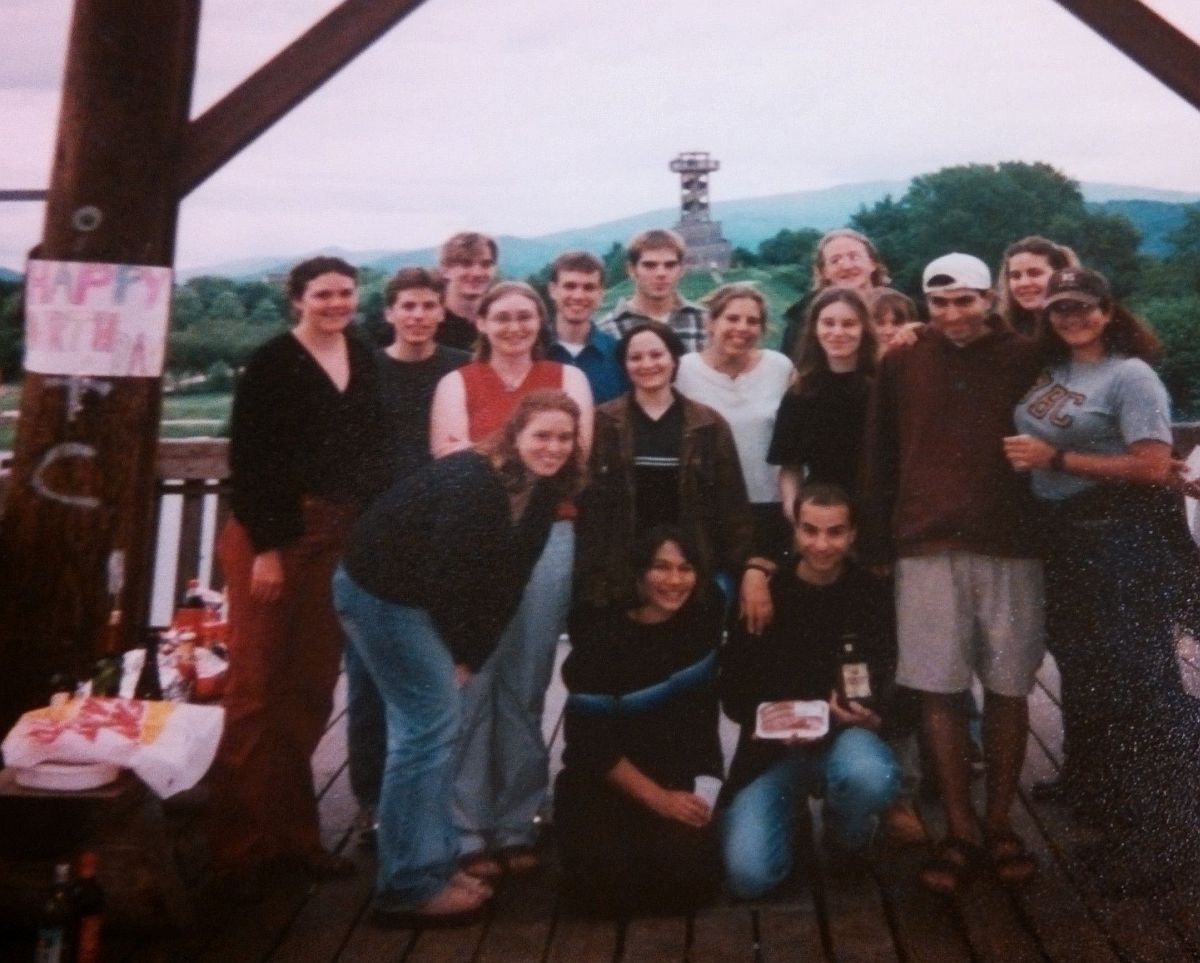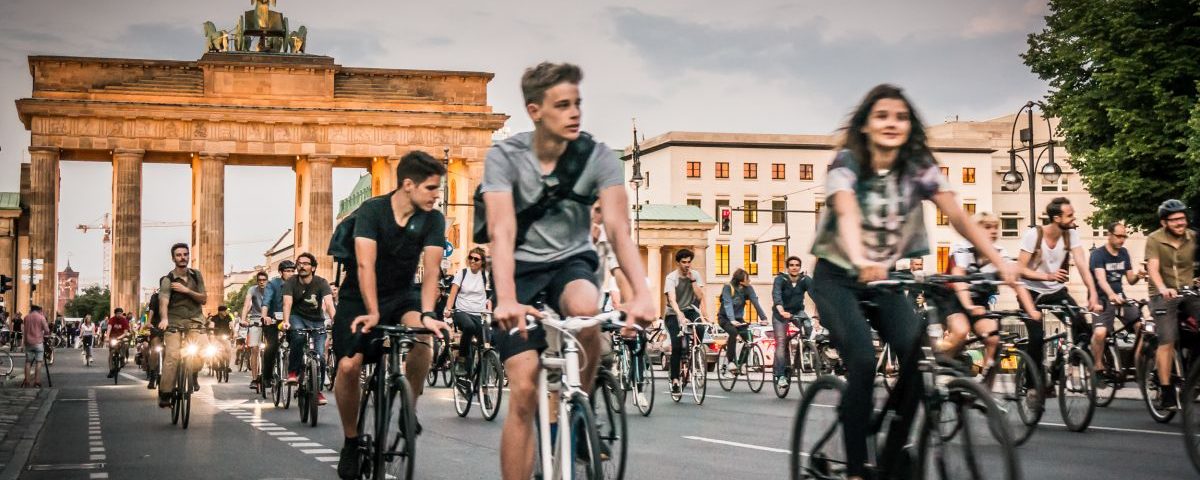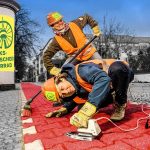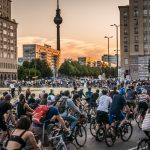AYF 2018-19 ~ Fall Impressions
2018-12-19
20th Reunion in Freiburg
2018-12-19Changing German Bicycle Culture

Changing German Bicycle Culture by Referendum: Case Study Berlin
An Interview with Dirk von Schneidemesser (AYF 2004-05)
The Volksentscheid Fahrrad (VEF), or Berlin’s Bicycle Referendum, is an initiative which was started at the end of 2015 with the goal of passing a bicycle law which requires the city of Berlin to build more and better bicycle infrastructure.
The initiative went public in early 2016 with 10 goals that were to be integrated in the law, including protected bike lanes on all main streets, bike highways, safe intersections, and more. With participative methods like Germany’s first Legislation Hackathon, the initiative wrote a law and began the process to pass the law via a referendum. Of the three necessary steps, only the first one was taken; instead of the 20,000 signatures needed within six months, the VEF was able to gather more than 100,000 signatures in just over three weeks. The center-left government in Berlin, elected in September of 2016, agreed to pass the law without the referendum. After constant pressure from the VEF, Germany’s first bicycle law was passed in July 2018. The initiative, now evolved to ‘Changing Cities’, now helps other cities follow a similar strategy, as well as making sure the law is actually implemented in Berlin. The work has only just begun.
Germany has a reputation of being bicycle-friendly…
1. Why do you think the number of cars is increasing in Berlin? The number of cyclists? Do you think these are related, and if so, in what ways?
Berlin, like many cities, is growing. More people are coming here, and people now are more mobile than ever. The number of cars is increasing at an alarming rate, enough cars to fill the entire Tempelhofer Airfield are being registered in Berlin every 10 years. But Berlin is not getting any bigger. The city is built for cars, so people use cars. It’s really that simple. In spite of that, the number of cyclists is increasing as well. Many people realize that it’s healthier, more convenient, more fun, and more affordable to ride a bike, and so they choose this option. It would be many more if the city was built to accommodate cycling, and that’s what we’re trying to achieve.
2. Is Berlin’s bicyclist population demographically changing? If so, how?
Yes. Especially young people are cycling more, but cycling is also expanding in many different groups. You see seniors riding e-bikes, Suit-wearers cruising around downtown, and the cargo-bike is no longer just for hipster parents, Chimney sweeps and ladies with headscarves are pedaling cargo-bikes around the city more and more.
3. Why do you think (maybe multiple reasons) Berlin’s former cycling policy (2013 – 2015) didn’t work out? What’s different about the approach you took with the bicycle referendum (VEF)?
Berlin’s former cycling strategy was not actually that bad. The problem was, it was a strategy that wasn’t implemented, an unfulfilled promise. The VEF was concerned with making sure that a strategy was binding, because we had been disappointed for too long with the lip-service given to cycling. It is very frustrating to hear pro-cycling rhetoric from across the political spectrum, but not experience any real change. We wanted something that couldn’t be conveniently forgotten. Rules and regulations are very important in Germany, so we decided to push for a law to ensure that goals would be met and attach it to a binding timeframe.
Berlin appears a very diverse city…
4. How did referendum organizers go about bringing different voices to the table?
I think we struck a nerve by saying what a lot of people were thinking anyway. We want a bike-friendly city… That’s a message where a lot of very different people can get on board. Germany is very corporatist, which means that clubs and social institutions from football (soccer) teams to churches to environmental groups play an important role in how society is organized. Therefore, we reached out to many organizations. At the same time, we knew that over the past 30 or so years, the existing organizations had not achieved the change we need. So we made our own concrete goals and made sure to stick to those while engaging with other actors.
5. Were there opinions and perspectives VEF organizers were surprised to encounter? If so, which ones, and how were these accounted for in establishing the Referendum?
At the beginning, it wasn’t clear that we all were in favor of bicycle lanes physically separated from automobile traffic, but we realized very soon that this was an important point. There, we got into a conflict with the long established General German Bicycle Club (ADFC), generally considered the main bicycle lobby. The Berlin chapter of the ADFC was not happy about our demand for protected bike lanes. They had been working on getting on-street bike lanes for a long time. The major difference is, the VEF oriented our work toward people who might like to cycle, but don’t yet. Established bicycle advocates were aiming to make things better for people who already bicycle. To make a major transition from the automobile to active transport, we need to make cycling available to everyone… and for that, people need to feel safe while cycling. The initial friction between the VEF and established cycling groups was surprising, but we stuck to our goals and were able to convince them. We now work together very productively.
6. Do you think this Referendum was established with enough input from Berlin’s bicyclists? Why?
This was an important step for Berlin, also for those who don’t (and even those who won’t) cycle. Stefan, one of our most active volunteers, doesn’t even ride a bike himself. But he acknowledges the power of the bicycle as a lever to make the city more people friendly. With our car-centric cities, we’re poisoning the air we breathe, we’re too inactive, we get into the trap of needing a car to get a job… and needing a job to pay for the car, for example. Children have to play inside because we’ve let cars play everywhere outside. Cities like Vancouver are tearing down their city highways because they divide and break communities, in Berlin we’re building highways right through neighborhoods. That has to stop! But we have to offer alternatives, because we need to remain mobile to be active members of society. The bicycle is a good alternative; but making a bicycle-friendly city is not only about bicyclists. Everybody profits from more people-oriented cities.
Maybe this will be a very good thing…
7. What challenges do you foresee in the next ten years for the VEF?
The administration was reduced to a minimum in Berlin over the past 15 years due to cutbacks in government spending. So Berlin doesn’t have the capacity needed to implement the contents of the law. Further, the people Berlin does have in the administration regarding city and traffic planning have lots of experience building a car-oriented city. We need new ideas and new energy in the administration. With the bicycle law, they have a good guideline, but it’s not easy to teach an old dog new tricks.
8. Describe what you imagine it would feel like to live in Berlin ten years from now, after the VEF has had time to develop.
People are healthier, the air is cleaner. You feel like a part of your city, because you pass your neighbors on the street not behind your windshield, so you can say ‘hi.’ There’s more life on the streets, because our public space is not filled up with other people’s private property in the form of cars, kids can run around more freely. There’s less aggression in traffic, because each form of transit has its own clear space allotted and that minimized conflicts.
9. Do you think the VEF methodology could be applied to other sustainable policy initiatives? How so?
Maybe it can. People like to say that there’s less participation in politics these days. I don’t agree. The participation looks different, but it’s there. I think it’s important to break down things like ‘sustainability policy’ to changes that people can understand and changes that people can get behind. We want to be able to be safe and relaxed while cycling… I think anybody can understand that, and we communicated clearly what that would mean. It’s not some abstract thing that you can’t fathom.
10. How do you hope to see Berlin’s bottom-up and top-down approaches to transportation policy interacting in the future?
Hopefully soon the political parties will realize that as far as transport goes, citizens are much further than politicians like to believe. Yes, it probably was the case before that if you curtailed the privileges of motorists, you’d lose votes. But that has changed. An important lesson for political leaders from the VEF was that you can win elections with the bicycle. People didn’t believe that before, and for some it still seems to be sinking in.
11. What can other cities learn from the VEF Referendum? What can Freiburg learn?
When you take away some of the privileges of automobile use, it will at first feel like oppression to those who are used to the privilege. So initially, there’s going to be a conflict. If we all agreed on everything, there would be no need to work together. New collaboration grows out of carrying out a conflict. Freiburg has already achieved a lot, its car-free city center attracts people from around the world. Freiburg, having won a reputation as a progressive and green city, however, has also gotten lazy. Vauban, a low-car neighborhood in Freiburg, was largely a successful idea. It has been almost 20 years since the first people moved in there. It would be great to see the lessons from that project be taken further. I’m also missing any really bold steps to prioritize public transport and the bicycle in the whole of Freiburg. Here again, I think that citizens are likely further and open to innovative schemes. It won’t be easy, but that doesn’t mean we shouldn’t try.
 Dirk von Schneidemesser is a UW-Madison and AYF alumnus (04-05), who volunteered with the Volksentscheid Fahrrad (Berlin’s Bicycle Referendum, VEF for short) and is on the board of Changing Cities e.V., the organization responsible for Germany’s first Bicycle Law in Berlin. Now, Changing Cities is working to spread the movement to other cities in Germany (Bamberg, Darmstadt, Frankfurt, and Kassel have already completed the first major steps, following the Berlin model), Dirk contributes to strategic communication, outreach, and coordination of volunteers.
Dirk von Schneidemesser is a UW-Madison and AYF alumnus (04-05), who volunteered with the Volksentscheid Fahrrad (Berlin’s Bicycle Referendum, VEF for short) and is on the board of Changing Cities e.V., the organization responsible for Germany’s first Bicycle Law in Berlin. Now, Changing Cities is working to spread the movement to other cities in Germany (Bamberg, Darmstadt, Frankfurt, and Kassel have already completed the first major steps, following the Berlin model), Dirk contributes to strategic communication, outreach, and coordination of volunteers.
Andy Awve is a UW-Madison and AYF alumnus (16-17), pursuing his master’s degree in energy and resource economics. Andy was inspired by his positive  experiences with Critical Mass (Freiburg) and wanted to find out more about the societal role and form of „bike culture“ in Berlin through the this email interview with Dirk.
experiences with Critical Mass (Freiburg) and wanted to find out more about the societal role and form of „bike culture“ in Berlin through the this email interview with Dirk.
Photos © Changing Cities e.V. (except A. Awve)


